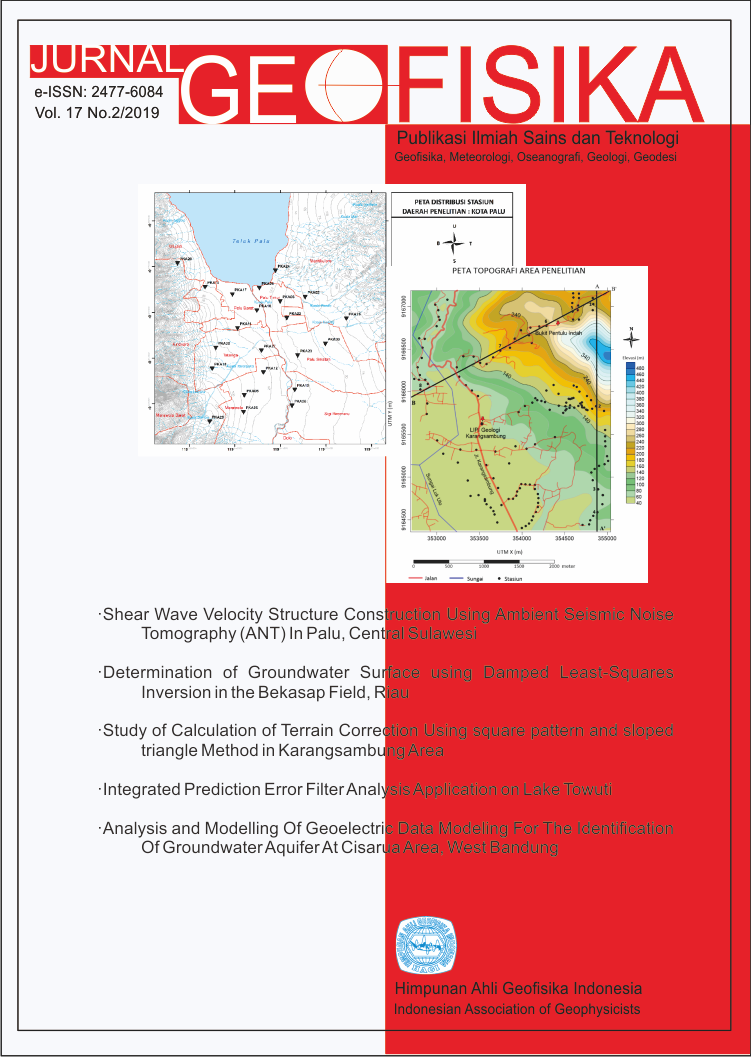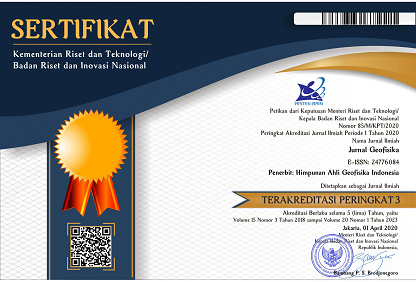Determination of Groundwater Surface using Damped Least-Squares Inversion in the Bekasap Field, Riau
Abstract
Groundwater is a primary water source for the sustainability of human life. Groundwater is located in the subsurface area in the saturated zone called aquifer. The presence of an aquifer can be identified through a geophysical survey by determining the upper boundary of the aquifer called the groundwater table. DC Resistivity geoelectrical method is one of the geophysical measurements which is effective to be used to determine the depth of the water table. Measurements were performed using the Wenner electrode configuration in Bekasap to attain preferable depth resolution. The process of measurement data modelling yields rms error. In order to reduce the rms error, damped least-squares is applied into the inversion solution. This process will improve the model parameter iteratively until the minimum rms error is obtained. The damped least-squares modeling was tested on three synthetic models which have Resistivity variation. Furthermore, the damped least-squares was applied on the observed data at Bekasap. From the processing and modeling using damped least-squares, the depth of the groundwater table and aquifer can be obtained.
References
Kirsch, R. (2009). Groundwater Geophysics: A Tool for Hydrogeology. Springer.
Koefoed, O. (1979). Geophysical Principal. Elsevier Scientific Publishing Company.
Ghosh, D. P. (1970). The Application of Linear Filter Theory to the Direct Interpretation of Geoelectrical Resistivity Measurements. Doctoral thesis. TU Delft.
Ghosh, D. P. (1971). The Application of Linear Filter Theory to The Direct Interpretation of Geoelectrical Resistivity Sounding Measurements. Geophys. Prospect.
Ekinci, Y. L. dan Demirci. A. (2008). A Damped Least-Squares Inversion Program for the Interpretation of Schlumberger Sounding Curves. Journal of Applied Sciences.
Levenberg, K. (1944). A Method for The Solution of Certain Non-Linear Problems in Least-Squares. Quart. Appl. Math
Marquardt, D. W. (1963). An Algorithm for Least-Squares Estimation of Nonlinear Parameters. Journal of the Society for Industrial and Applied Mathematics.
Meju, M. A. (1994). Geophysical Data Analysis: Understanding Inverse Problem Theory and Practice. Society of Exploration Geophysic Course Notes Series, No. 6, 1st Edition. SEG Publisher, Tulsa, Oklahoma.
Grandis, H. (2009). Pengantar Pemodelan Inversi Geofisika. Himpunan Ahli Geofisika Indonesia.

This work is licensed under a Creative Commons Attribution 4.0 International License.
The copyright of all articles belongs to the authors. All other copyrights is held by the Journal











